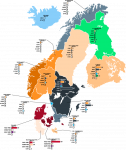- Location
- Das Böse ist immer und überall
- Pronouns
- he/him
I definitely think the scales should be the same for every party.

My EYES!
Perhaps some spoiler tags with an epilepsy warning there, Makemakemax?

...it was of course only much later that I realized that, yeah, maybe there's also something inadvisable about making a joke about that episode of Pokémon that was banned in Japan because kids were taken to hospitals due to epilepsy by literally reproducing that very effect?

your handwriting reminds me quite a bit of that in the horrible histories books. I love it and it makes me nostalgic for that year I lived in London when I was 12.
In line with the delightful story you gave us about that most quixotic of marquis, I'd be very glad to read about a snapshot of either the 1885 or 1891 splits.
I'd be remiss not to point out that there's a fourth major city in the south in any TL where Sweden doesn't bury the hatchet for 200 years - although a) it probably still isn't as big as the ones you listed, and b) it's going to be a massively Unionist city until at least the point where we get universal suffrage.Mainly from the more urban Liberals, and then usually focused in the South (Copenhagen, Malmö, and Gothenburg).
I'd be remiss not to point out that there's a fourth major city in the south in any TL where Sweden doesn't bury the hatchet for 200 years - although a) it probably still isn't as big as the ones you listed, and b) it's going to be a massively Unionist city until at least the point where we get universal suffrage.
